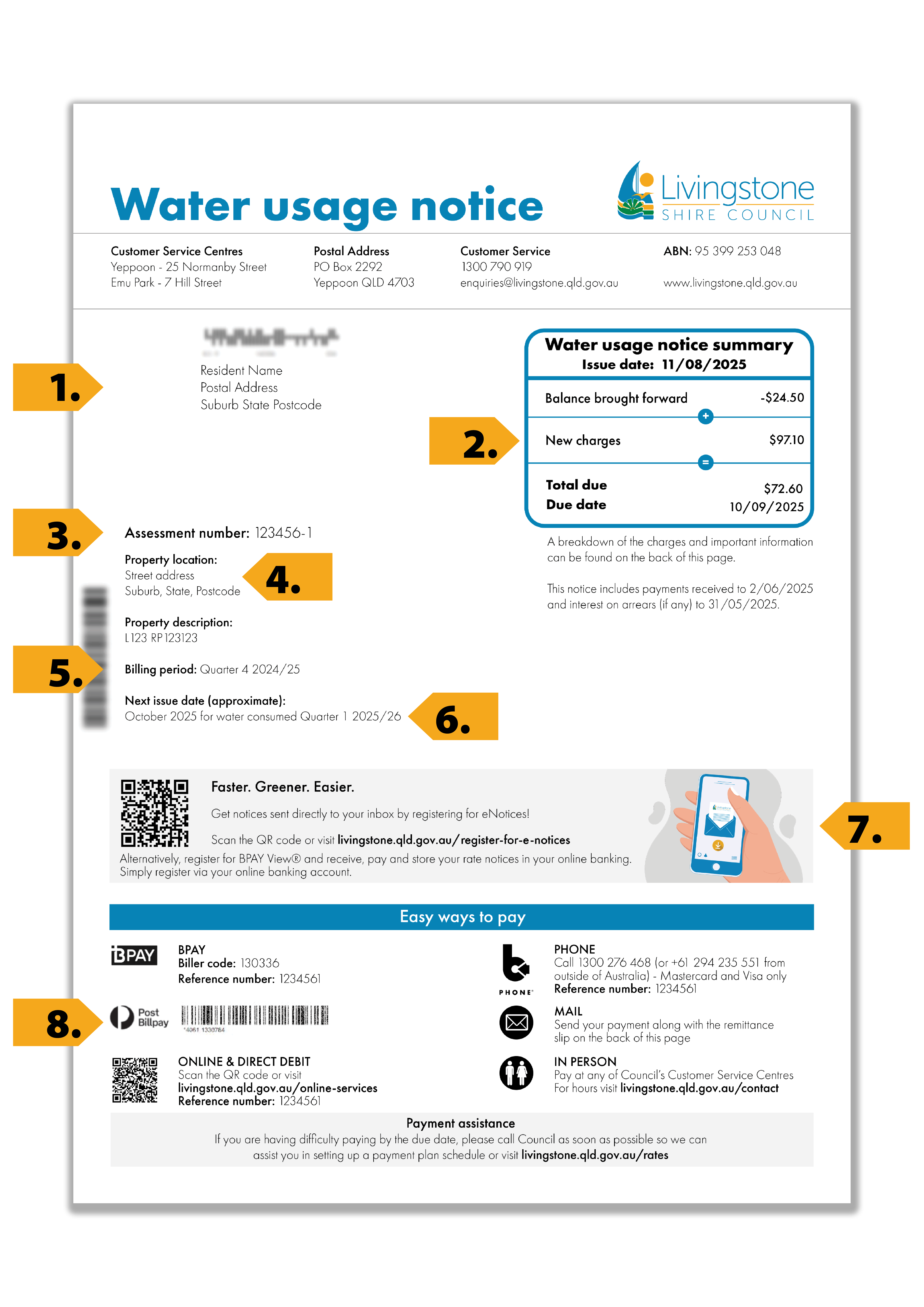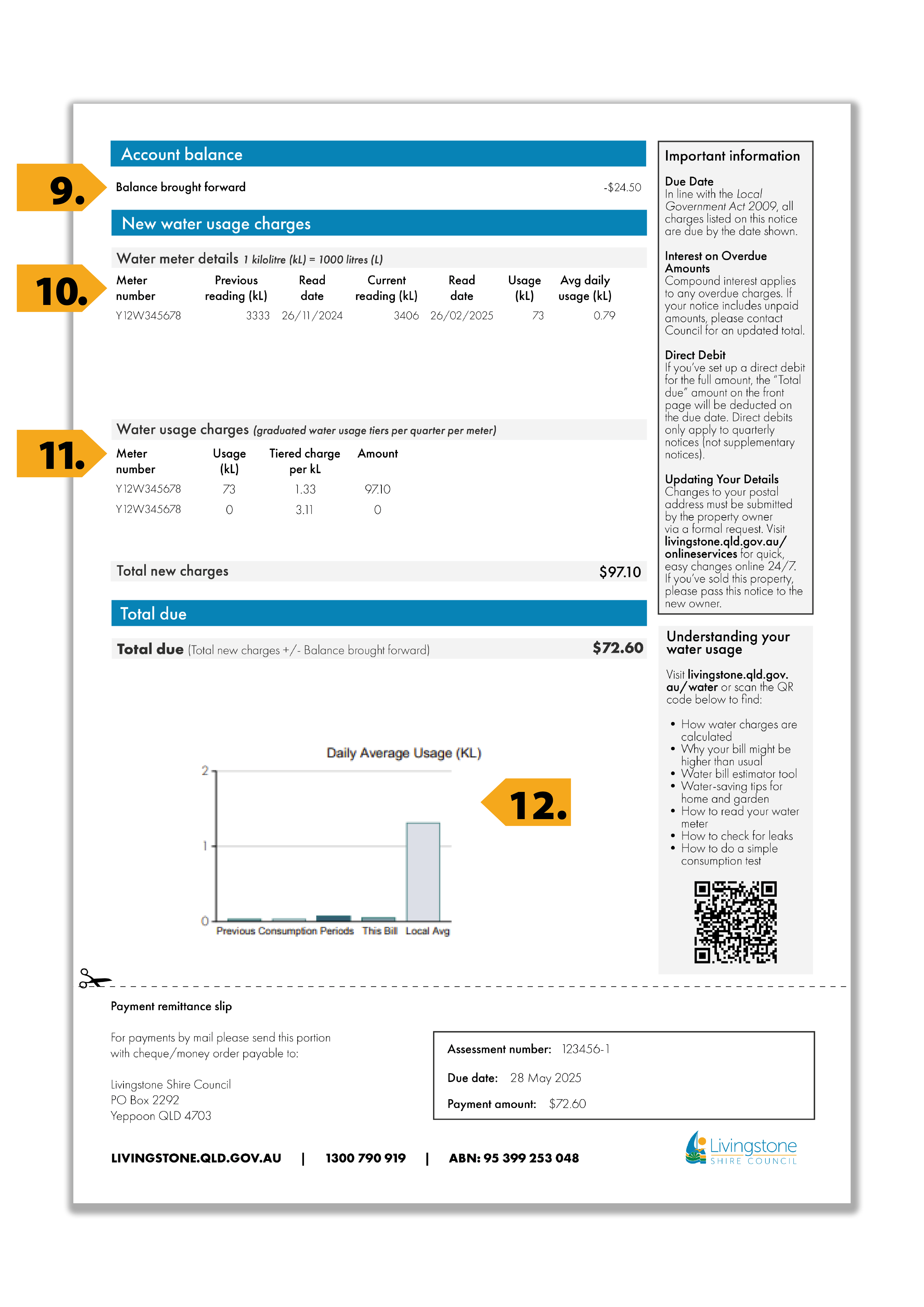Your Water Usage Notice Explained

Page 1 of your quarterly water usage notice
-
The name and postal address of the property owner/s. Have you changed your postal address? Update your details.
-
A summary of your usage charges, including the balance brought forward, new charges, and total amount owing as outlined:
- Issue date is the official date the rate notice was issued.
- If Account balance shows a CR after the amount that means credit (payments you've already made to this notice).
- New charges for this quarter - a detailed breakdown of these charges is on page 2.
- Total due is the new charges plus or minus the balance brought forward.
- Due date is when your rates are due to be paid. If you are having trouble paying your rates, please contact Council before your rates become overdue and accrue interest.
See what payment options are available.
-
Have the assessment number handy when contacting Council about your water usage notice.
Use this when paying your bill – if you have more than one property, each property will have its own assessment number.
-
This is the property address that is being billed and where the water was used. This may be different to your postal address.
-
This is the time period we are charging you for on this bill and is the period of time between your last two water meter reading dates.
The days shown is the number of days you are being charged for on each bill. Billing periods are usually between 85 and 95 days.
-
This is an approximate date only. Please make sure your water meter is clear and accessible at all times so our water meter readers can access it easily.
Learn how to read your water meter so you can monitor your water usage by conducting regular checks of your meter reads (we recommend weekly) to help monitor usage and identify potential concealed leaks. Our water bill estimator is a handy tool for residents and business owners to monitor water usage and estimate quarterly costs.
-
Rate payers can choose to receive their rate and water usage notices via email. With the increased cost of postage and longer delivery times, this service provides a faster, more reliable, and environmentally friendly alternative to paper copies.
-
All the ways you can make payment. Visit our payment options page for more information.

Page 2 of your quarterly water usage notice
-
This shows if you have any arrears on your previous notice/s or if you have credit towards your current notice. A credit amount will show with a "CR" after the amount.
-
A detailed breakdown of the charges that apply to your property's water meter/s, including:
Meter number
This shows the identification number of the meter/s connected to your property.Previous previous reading and read date
This shows the date and total amount of water in kilolitres (kL) recorded for this property at the start of the billing period.Current reading and read date
This shows the date and total amount of water in kilolitres (kL) recorded for this property at the end of this billing period. Billing periods are usually 90 days but may vary by several days either way.Usage (kL)
This is the total amount of water in kilolitres (kL) used during this billing period and is the 'Current reading (kL)' minus the 'Previous reading (kL)'.Average daily usage (kL)
Average daily usage in kilolitres (kL) is calculated by dividing your total usage by the number of days in the billing period.Please note: 1 kilolitre (kL) = 1000 litres (L)
FInd out more about water meter readings by visiting our Reading Your Water Meter page.
-
This section of your notice shows how much water was used at your property for the billing period, broken down by meter number and charged using Council’s two‑tier charging system.
Your total usage is measured in kilolitres (kL), with 1 kL = 1,000 litres.
- Tier 1 covers your initial usage and is charged at a lower rate per kL.
- Tier 2 applies once your usage exceeds the Tier 1 limit and is charged at a higher rate per kL.
The table in this section shows your meter number, total water used (in kL), how many kL were charged in each tier, the price per kL for each tier, and the total amount charged.
The more water you use, the more you’ll pay in Tier 2. This system encourages responsible water use while covering the costs of supplying, treating and maintaining the water network.
Our Water Saving Tips offer simple things you can do in your home and garden to save water and reduce your bill.
-
This graph allows you to compare your water usage over time by showing your average daily usage for the last four quarters. This graph also allows you compare your households daily water usage against the average household usage across the shire.